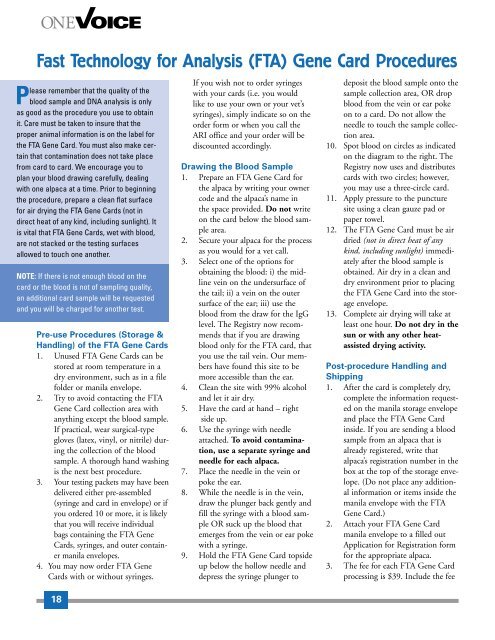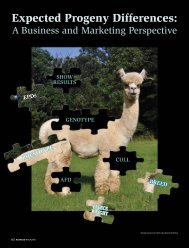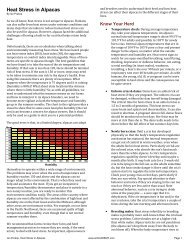IN THIS ISSUE: pgs 6-14 pgs 24-37 pgs 38-42 SEE YOU AT: - ariLIST
IN THIS ISSUE: pgs 6-14 pgs 24-37 pgs 38-42 SEE YOU AT: - ariLIST
IN THIS ISSUE: pgs 6-14 pgs 24-37 pgs 38-42 SEE YOU AT: - ariLIST
Create successful ePaper yourself
Turn your PDF publications into a flip-book with our unique Google optimized e-Paper software.
Fast Technology for Analysis (FTA) Gene Card Procedures<br />
Please remember that the quality of the<br />
blood sample and DNA analysis is only<br />
as good as the procedure you use to obtain<br />
it. Care must be taken to insure that the<br />
proper animal information is on the label for<br />
the FTA Gene Card. You must also make certain<br />
that contamination does not take place<br />
from card to card. We encourage you to<br />
plan your blood drawing carefully, dealing<br />
with one alpaca at a time. Prior to beginning<br />
the procedure, prepare a clean flat surface<br />
for air drying the FTA Gene Cards (not in<br />
direct heat of any kind, including sunlight). It<br />
is vital that FTA Gene Cards, wet with blood,<br />
are not stacked or the testing surfaces<br />
allowed to touch one another.<br />
NOTE: If there is not enough blood on the<br />
card or the blood is not of sampling quality,<br />
an additional card sample will be requested<br />
and you will be charged for another test.<br />
Pre-use Procedures (Storage &<br />
Handling) of the FTA Gene Cards<br />
1. Unused FTA Gene Cards can be<br />
stored at room temperature in a<br />
dry environment, such as in a file<br />
folder or manila envelope.<br />
2. Try to avoid contacting the FTA<br />
Gene Card collection area with<br />
anything except the blood sample.<br />
If practical, wear surgical-type<br />
gloves (latex, vinyl, or nitrile) during<br />
the collection of the blood<br />
sample. A thorough hand washing<br />
is the next best procedure.<br />
3. Your testing packets may have been<br />
delivered either pre-assembled<br />
(syringe and card in envelope) or if<br />
you ordered 10 or more, it is likely<br />
that you will receive individual<br />
bags containing the FTA Gene<br />
Cards, syringes, and outer container<br />
manila envelopes.<br />
4. You may now order FTA Gene<br />
Cards with or without syringes.<br />
18<br />
If you wish not to order syringes<br />
with your cards (i.e. you would<br />
like to use your own or your vet’s<br />
syringes), simply indicate so on the<br />
order form or when you call the<br />
ARI office and your order will be<br />
discounted accordingly.<br />
Drawing the Blood Sample<br />
1. Prepare an FTA Gene Card for<br />
the alpaca by writing your owner<br />
code and the alpaca’s name in<br />
the space provided. Do not write<br />
on the card below the blood sample<br />
area.<br />
2. Secure your alpaca for the process<br />
as you would for a vet call.<br />
3. Select one of the options for<br />
obtaining the blood: i) the midline<br />
vein on the undersurface of<br />
the tail; ii) a vein on the outer<br />
surface of the ear; iii) use the<br />
blood from the draw for the IgG<br />
level. The Registry now recommends<br />
that if you are drawing<br />
blood only for the FTA card, that<br />
you use the tail vein. Our members<br />
have found this site to be<br />
more accessible than the ear.<br />
4. Clean the site with 99% alcohol<br />
and let it air dry.<br />
5. Have the card at hand – right<br />
side up.<br />
6. Use the syringe with needle<br />
attached. To avoid contamination,<br />
use a separate syringe and<br />
needle for each alpaca.<br />
7. Place the needle in the vein or<br />
poke the ear.<br />
8. While the needle is in the vein,<br />
draw the plunger back gently and<br />
fill the syringe with a blood sample<br />
OR suck up the blood that<br />
emerges from the vein or ear poke<br />
with a syringe.<br />
9. Hold the FTA Gene Card topside<br />
up below the hollow needle and<br />
depress the syringe plunger to<br />
deposit the blood sample onto the<br />
sample collection area, OR drop<br />
blood from the vein or ear poke<br />
on to a card. Do not allow the<br />
needle to touch the sample collection<br />
area.<br />
10. Spot blood on circles as indicated<br />
on the diagram to the right. The<br />
Registry now uses and distributes<br />
cards with two circles; however,<br />
you may use a three-circle card.<br />
11. Apply pressure to the puncture<br />
site using a clean gauze pad or<br />
paper towel.<br />
12. The FTA Gene Card must be air<br />
dried (not in direct heat of any<br />
kind, including sunlight) immediately<br />
after the blood sample is<br />
obtained. Air dry in a clean and<br />
dry environment prior to placing<br />
the FTA Gene Card into the storage<br />
envelope.<br />
13. Complete air drying will take at<br />
least one hour. Do not dry in the<br />
sun or with any other heatassisted<br />
drying activity.<br />
Post-procedure Handling and<br />
Shipping<br />
1. After the card is completely dry,<br />
complete the information requested<br />
on the manila storage envelope<br />
and place the FTA Gene Card<br />
inside. If you are sending a blood<br />
sample from an alpaca that is<br />
already registered, write that<br />
alpaca’s registration number in the<br />
box at the top of the storage envelope.<br />
(Do not place any additional<br />
information or items inside the<br />
manila envelope with the FTA<br />
Gene Card.)<br />
2. Attach your FTA Gene Card<br />
manila envelope to a filled out<br />
Application for Registration form<br />
for the appropriate alpaca.<br />
3. The fee for each FTA Gene Card<br />
processing is $39. Include the fee





